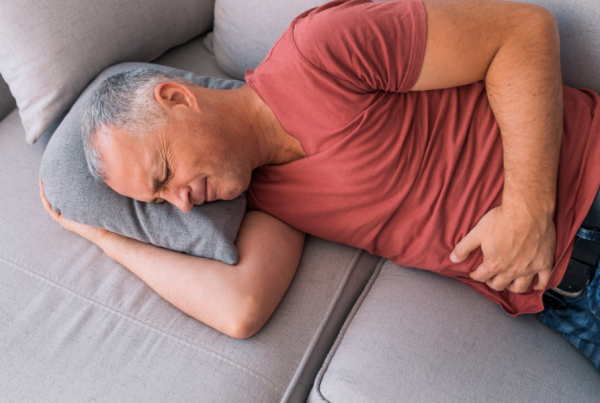Chronic Prostatitis
Move Better. Live Fuller. Your Wellness Journey Starts Here.
Schedule a FREE Discovery Call!
What Is Chronic Prostatitis?
Prostatitis is a disorder of the prostate gland, a gland found in people born with a penis. This gland is located in front of the rectum and below the bladder, and is an important gland for sexual function.
It allows for fluid to be added to semen, and helps push this fluid through the urethra during ejaculation. It surrounds the top portion of the urethra, so conditions of the prostate can affect urination, too.
Chronic prostatitis is a common form of prostatitis, which creates symptoms that aren’t directly caused by an infection. Typically, prostatitis is characterized by the presence of bacteria or the lack thereof.

There are actually four types of prostatitis—let’s take a look at each:
- Acute bacterial prostatitis: A less common form of prostatitis that suddenly causes severe symptoms, such as fever or chills in addition to other pelvic pain symptoms. It is caused by a bacterial infection.
- Chronic bacterial prostatitis: A long-term form of prostatitis that causes less severe symptoms over the course of many months. It is also caused by a bacterial infection.
- Chronic prostatitis or chronic pelvic pain symptom (CP / CPPS): This is the most common type of prostatitis, which causes symptoms without the presence of an infection. This type may affect an individual’s ability to urinate, as well as cause pelvic pain and other symptoms (which we’ll look at very soon).
- Asymptomatic inflammatory prostatitis: This condition refers to inflammation of the prostate that does not cause any symptoms.
Symptoms caused by prostatitis depend on the specific type of prostatitis (for this post, we’re focusing on chronic prostatitis or CPPS). Chronic prostatitis or CPPS can cause a variety of symptoms that may come and go, such as:
- Painful urination
- Difficulty with urination or urinary hesitancy
- Urinary urgency
- Incomplete bladder emptying
- Changes in urine appearance, such as cloudiness or bleeding
- Low back pain
- Groin pain
- Pain in the perineum
- Pain in the abdomen
- Genital discomfort
- Painful ejaculation
What Causes Chronic Prostatitis?
Chronic prostatitis can be difficult to diagnose as it doesn’t have an obvious cause. It can also be confusing as its symptoms often mimic many other conditions; for example, pelvic pain is a common symptom that can be caused by a variety of factors and conditions.
Therefore, diagnosis of prostatitis requires a thorough review of your symptoms and medical history, examinations, laboratory tests, ruling out other conditions, and image tests in some cases.
Some possible causes thought to create chronic prostatitis include the following:
- Previous infections
- Irritation from a backup of urine into the prostate ducts
- Nerve complications
- Injury or trauma to the area
- Muscle tension or spasms
- Pelvic floor dysfunction
Oftentimes if there are no results yielding from testing and other diagnosis methods, it is highly likely for the cause to be pelvic floor dysfunction. The prostate and pelvic floor are located very close to one another. In fact, the prostate lies within the muscles of the pelvic floor. The prostate also has connective tissue that affixes it to the bladder, urethra, pelvic bones, and other structures.
The pelvic floor holds your pelvic organs like the bladder or rectum, and is attached to many areas throughout the pelvis. Additionally, the pelvic floor allows for important functions including bowel, bladder, and sexual functions—so the pelvic floor muscles need to be in good health to allow for these important activities.
When the pelvic floor and other pelvic muscles are too tight or imbalanced, this can affect the prostate. Imbalanced pelvic floor muscles and other structures can refer pain to the prostate area, and vice versa. Pelvic floor physical therapy can be an appropriate form of treatment for chronic prostatitis or CPPS, especially when other tests aren’t proving useful.
Physical Therapy for Chronic Prostatitis
So, how can chronic prostatitis symptoms be relieved with pelvic floor physical therapy? Pelvic floor physical therapy can address pain and other side effects of chronic prostatitis by relieving tension, tightness, imbalances, and incoordination of the pelvic floor muscles. Your physical therapist can improve the health of these muscles, relieve your pain, and teach you methods to prevent muscle tension from building up again in the future.
To start, your physical therapist will analyze your pelvic floor health and identify any areas of imbalance, sensitivity, tightness, weakness, or trigger points. They will create a comprehensive care plan to improve these areas, which can include activities such as:
Pelvic Floor Training
Using treatments such as biofeedback and neuromuscular education can help patients become more familiar with their pelvic floor muscles, and what they should feel like during contraction or relaxation. This will help patients learn how to relax their muscles, in addition to participating in other tension-reducing techniques such as manual therapy and deep breathing.
Pain Management
While working towards long-term pelvic floor health improvement, which will reduce pain overall, your physical therapist will tend to your pain with manual techniques that can address trigger points and relieve tension. These manual therapies may be done externally to the pelvic area, or internally to the pelvic floor muscles.
Improving Strength and Flexibility
Pelvic floor dysfunction can create an imbalance of the entire pelvic area, so your physical therapist may work on improving the strength and flexibility of muscles in the pelvic floor, abdominals, low back, hips, and other necessary areas to promote alignment, mobility, and balance. This can involve exercises and stretching routines for all of these areas. Rebalancing the muscles of all these areas will prevent tension build-up and provide pain relief from prostatitis.
Behavioral Modifications
The above activities will take pressure off of the pelvis and bladder, as well as improve pelvic floor function to allow for optimal urinary and sexual function. However, there are certain postures and restroom habits that can be harmful to the pelvic floor and may worsen tension in the pelvis.
Your physical therapist will improve your standing and sitting posture to alleviate pressure on the pelvis. They’ll educate you on proper toilet posture and other restroom habits (frequency, how to handle urgency, etc.) to improve long-term health and reduce urinary symptoms.
Relaxation Techniques
To further reduce muscle tension, your physical therapist can teach you relaxation techniques such as diaphragmatic breathing. This technique can not only relax pelvic floor muscles, but also reduce stress and anxiety associated with chronic prostatitis symptoms.
Education and Resources
Dealing with chronic prostatitis can be stressful and confusing. The physical therapists at Hive Therapy and Wellness are experts of the body, and are determined to provide a holistic care experience for every patient. That’s why they are happy to answer your questions, provide education, and suggest other resources or tools that may help you throughout your healing journey.
Symptoms of chronic prostatitis can vary from person to person, as can pelvic floor dysfunction. That is why each patient at Hive Therapy and Wellness receives a unique care plan that is curated to their individual needs. Your physical therapist may use a variety of treatment methods to help you reach your health goals, including any of the following:
- Neuromuscular re-education
- Manual therapy
- Exercise prescription
- Dry needling
- Cupping
- Tissue scraping
- Behavioral modifications
- Therapeutic activities
- Electrical muscle stimulation
- Spinal manipulation
- Therapeutic modalities
- Biofeedback
Prostatitis is a disorder of the prostate gland, a gland found in people born with a penis. This gland is located in front of the rectum and below the bladder, and is an important gland for sexual function.
It allows for fluid to be added to semen, and helps push this fluid through the urethra during ejaculation. It surrounds the top portion of the urethra, so conditions of the prostate can affect urination, too.
Chronic prostatitis is a common form of prostatitis, which creates symptoms that aren’t directly caused by an infection. Typically, prostatitis is characterized by the presence of bacteria or the lack thereof.
There are actually four types of prostatitis—let’s take a look at each:
- Acute bacterial prostatitis: A less common form of prostatitis that suddenly causes severe symptoms, such as fever or chills in addition to other pelvic pain symptoms. It is caused by a bacterial infection.
- Chronic bacterial prostatitis: A long-term form of prostatitis that causes less severe symptoms over the course of many months. It is also caused by a bacterial infection.
- Chronic prostatitis or chronic pelvic pain symptom (CP / CPPS): This is the most common type of prostatitis, which causes symptoms without the presence of an infection. This type may affect an individual’s ability to urinate, as well as cause pelvic pain and other symptoms (which we’ll look at very soon).
- Asymptomatic inflammatory prostatitis: This condition refers to inflammation of the prostate that does not cause any symptoms.
Symptoms caused by prostatitis depend on the specific type of prostatitis (for this post, we’re focusing on chronic prostatitis or CPPS). Chronic prostatitis or CPPS can cause a variety of symptoms that may come and go, such as:
- Painful urination
- Difficulty with urination or urinary hesitancy
- Urinary urgency
- Incomplete bladder emptying
- Changes in urine appearance, such as cloudiness or bleeding
- Low back pain
- Groin pain
- Pain in the perineum
- Pain in the abdomen
- Genital discomfort
- Painful ejaculation
Chronic prostatitis can be difficult to diagnose as it doesn’t have an obvious cause. It can also be confusing as its symptoms often mimic many other conditions; for example, pelvic pain is a common symptom that can be caused by a variety of factors and conditions.
Therefore, diagnosis of prostatitis requires a thorough review of your symptoms and medical history, examinations, laboratory tests, ruling out other conditions, and image tests in some cases.
Some possible causes thought to create chronic prostatitis include the following:
- Previous infections
- Irritation from a backup of urine into the prostate ducts
- Nerve complications
- Injury or trauma to the area
- Muscle tension or spasms
- Pelvic floor dysfunction
Oftentimes if there are no results yielding from testing and other diagnosis methods, it is highly likely for the cause to be pelvic floor dysfunction. The prostate and pelvic floor are located very close to one another.
In fact, the prostate lies within the muscles of the pelvic floor. The prostate also has connective tissue that affixes it to the bladder, urethra, pelvic bones, and other structures.
The pelvic floor holds your pelvic organs like the bladder or rectum, and is attached to many areas throughout the pelvis.
Additionally, the pelvic floor allows for important functions including bowel, bladder, and sexual functions—so the pelvic floor muscles need to be in good health to allow for these important activities.
When the pelvic floor and other pelvic muscles are too tight or imbalanced, this can affect the prostate. Imbalanced pelvic floor muscles and other structures can refer pain to the prostate area, and vice versa.
Pelvic floor physical therapy can be an appropriate form of treatment for chronic prostatitis or CPPS, especially when other tests aren’t proving useful.
So, how can chronic prostatitis symptoms be relieved with pelvic floor physical therapy? Pelvic floor physical therapy can address pain and other side effects of chronic prostatitis by relieving tension, tightness, imbalances, and incoordination of the pelvic floor muscles.
Your physical therapist can improve the health of these muscles, relieve your pain, and teach you methods to prevent muscle tension from building up again in the future.
To start, your physical therapist will analyze your pelvic floor health and identify any areas of imbalance, sensitivity, tightness, weakness, or trigger points.
They will create a comprehensive care plan to improve these areas, which can include activities such as:
Pelvic Floor Training
Using treatments such as biofeedback and neuromuscular education can help patients become more familiar with their pelvic floor muscles, and what they should feel like during contraction or relaxation.
This will help patients learn how to relax their muscles, in addition to participating in other tension-reducing techniques such as manual therapy and deep breathing.
Pain Management
While working towards long-term pelvic floor health improvement, which will reduce pain overall, your physical therapist will tend to your pain with manual techniques that can address trigger points and relieve tension.
These manual therapies may be done externally to the pelvic area, or internally to the pelvic floor muscles.
Improving Strength and Flexibility
Pelvic floor dysfunction can create an imbalance of the entire pelvic area, so your physical therapist may work on improving the strength and flexibility of muscles in the pelvic floor, abdominals, low back, hips, and other necessary areas to promote alignment, mobility, and balance.
This can involve exercises and stretching routines for all of these areas. Rebalancing the muscles of all these areas will prevent tension build-up and provide pain relief from prostatitis.
Behavioral Modifications
The above activities will take pressure off of the pelvis and bladder, as well as improve pelvic floor function to allow for optimal urinary and sexual function.
However, there are certain postures and restroom habits that can be harmful to the pelvic floor and may worsen tension in the pelvis.
Your physical therapist will improve your standing and sitting posture to alleviate pressure on the pelvis. They will educate you on proper toilet posture and other restroom habits (frequency, how to handle urgency, etc.) to improve long-term health and reduce urinary symptoms.
Relaxation Techniques
To further reduce muscle tension, your physical therapist can teach you relaxation techniques such as diaphragmatic breathing. This technique can not only relax pelvic floor muscles, but also reduce stress and anxiety associated with chronic prostatitis symptoms.
Education and Resources
Dealing with chronic prostatitis can be stressful and confusing. The physical therapists at Hive Therapy and Wellness are experts of the body, and are determined to provide a holistic care experience for every patient.
That’s why they are happy to answer your questions, provide education, and suggest other resources or tools that may help you throughout your healing journey.
Symptoms of chronic prostatitis can vary from person to person, as can pelvic floor dysfunction. That is why each patient at Hive Therapy and Wellness receives a unique care plan that is curated to their individual needs.
Your physical therapist may use a variety of treatment methods to help you reach your health goals, including any of the following:
- Neuromuscular re-education
- Manual therapy
- Exercise prescription
- Dry needling
- Cupping
- Tissue scraping
- Behavioral modifications
- Therapeutic activities
- Electrical muscle stimulation
- Spinal manipulation
- Therapeutic modalities
- Biofeedback
You can learn more about these treatments on our Treatments Page.





